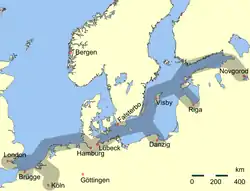Dutch–Hanseatic War
| Dutch–Hanseatic War | |||||||
|---|---|---|---|---|---|---|---|
 The main trading routes of the Hanseatic League | |||||||
| |||||||
| Belligerents | |||||||
|
|
| ||||||
| Commanders and leaders | |||||||
|
|
| ||||||
|
a: Eric of Pomerania was deposed as king of Denmark and Sweden in 1439, but retained the Norwegian throne until 1442, when Christopher of Bavaria succeeded in restoring the Kalmar Union of the three Scandinavian countries. b: Christopher of Bavaria was proclaimed King of Denmark, as Christopher III, on 9 April 1440. He was later elected king of Sweden in 1441, and Norway in June 1442. | |||||||
The Dutch–Hanseatic War[1] was a conflict between the Burgundian Netherlands and the Hanseatic League over the latter's control of Baltic shipping. It began in 1438 and ended with the 1441 Treaty of Copenhagen, which authorized unlimited Dutch access to the Baltic grain trade.
On 7 April 1438, Philip the Good, Duke of Burgundy allowed Dutch privateering against the six Wendish cities of the League—Hamburg, Lübeck, Lüneburg, Greifswald, Stettin (now Szczecin) and Anklam—and the Duchy of Holstein. On 23 April, the Hanseatic League informed its member cities of a possible war with Holland and advised shipping via Flanders, rather than Holland or Zeeland.
References
- Smout, T. Christopher (1992). Scotland and the Sea. Edinburgh: Rowman & Littlefield. p. 37. ISBN 9780859763387. Retrieved 21 December 2019.